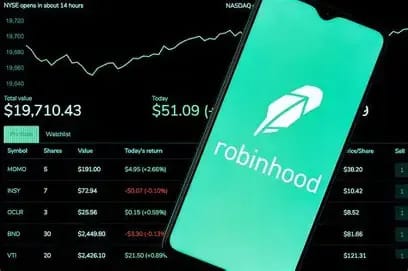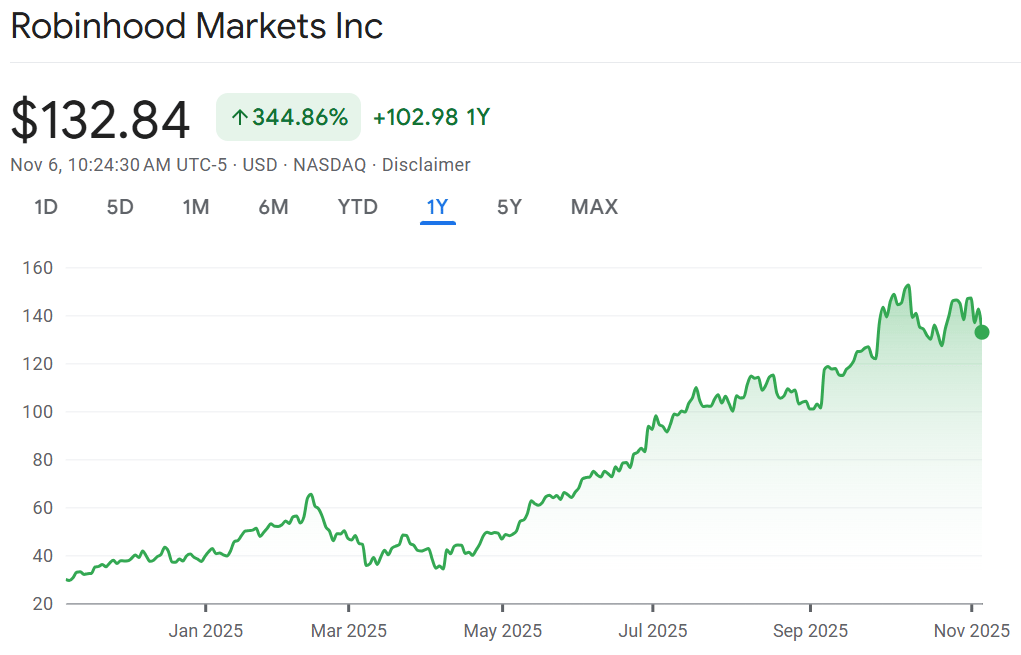- The Pragmatic Investor
- Posts
- Pragmatic Friday: 💰 129% Surge in Trading Revenue - Robinhood’s Just Getting Started
Pragmatic Friday: 💰 129% Surge in Trading Revenue - Robinhood’s Just Getting Started

🌞 Good Morning, Pragmatic Thinkers!
The market spent most of the week reacting to noise — the usual treadmill of headlines, sentiment swings, and “expert takes” recycled from last quarter. We saw the same pattern again: one strong earnings print sparks excitement, one red day sparks fear, and suddenly everyone is convinced the narrative has changed. It hasn’t. What changed was attention, not fundamentals.
Here’s the uncomfortable truth: most investors aren’t actually watching the business. They’re watching the chart, the crowd, or Twitter sentiment — and mistaking that for insight. The real story of this week wasn’t the volatility. It was who benefited from it.
The companies that execute quietly, compound quietly, and turn ridicule into repeatable results — those are the ones that win markets long after the hype cycles have burned out. And this week gave us a clear example of that shift in real time.
Everyone remembered Robinhood for what it was. Almost no one paid attention to what it was becoming.
So today, we’re not chasing headlines or reacting to the emotional whiplash of a red-green-red week. We’re zooming in on a business that the market wrote off — and the proof that the story has already changed.
Let’s talk about what actually mattered — and what it means when the numbers say “turnaround” long before the market is willing to admit it.
🔥 Market Pulse – What Actually Mattered This Week
The Motley Fool uses the “missed Chipotle” analog to highlight a company currently trading at a steep discount to potential future value — one that many investors seem to have written off. The signal here: when the market treats a business like yesterday’s opportunity, not tomorrow’s leader, you may find edge. If you ignore this kind of setup, you’ll be stuck watching others compounding while you stay safe.
This piece calls out three growth stocks that could benefit from the next wave of AI infrastructure — but the deeper takeaway is about the rotation from headline names into undervalued positions. When everyone’s focused on the megacaps, the smart money starts moving quietly. If you’re still anchored only in the “obvious winners,” you’re missing where the next leg of returns may be hidden.
Employers announced 153,074 job cuts in October, the most for that month since 2003, per Challenger data. This isn’t just a labor-market story — it’s a structural red flag flashing beneath market bulls. When layoffs surge even as stocks rally, it signals the growth narrative may be decoupling from economic reality. If you ignore this signal, you’ll find yourself positioned wrong when the cycle turns.
TOGETHER WITH OUR PARTNER
Your career will thank you.
Over 4 million professionals start their day with Morning Brew—because business news doesn’t have to be boring.
Each daily email breaks down the biggest stories in business, tech, and finance with clarity, wit, and relevance—so you're not just informed, you're actually interested.
Whether you’re leading meetings or just trying to keep up, Morning Brew helps you talk the talk without digging through social media or jargon-packed articles. And odds are, it’s already sitting in your coworker’s inbox—so you’ll have plenty to chat about.
It’s 100% free and takes less than 15 seconds to sign up, so try it today and see how Morning Brew is transforming business media for the better.
🎯 The Pragmatic Playbook: Why HOOD’s Turnaround Is a Position You Build, Not Chase

The market loves to act like it knows everything.
It loves to build narratives, declare winners and losers, and pretend the story is already finished.
And for the past two years, the market treated Robinhood like it was done.
Washed.
A pandemic-era gimmick with no staying power.
“Retail traders are gone.”
“Crypto is dead.”
“Everyone closed their accounts and moved on.”
But this week, the numbers told the truth that sentiment didn’t want to say out loud.
Robinhood reported revenue of about $1.27 billion, up around 100% year-over-year.
Transaction-based revenue surged 129% to about $730 million.
And most importantly:
They remained profitable, clocking in at roughly $0.61 earnings per share.
This isn’t luck.
This isn’t stimulus.
This isn’t a meme rally.
This is a business that kept building, even while everyone laughed.
So let’s get into what changed, what matters, and how to play this as an investor who wants to be early when the market wakes up late.
📊 The Numbers That Change the Story
Metric | Result | What It Means |
|---|---|---|
Total Revenue | ~$1.27B, up ~100% YoY | Growth is back and accelerating |
Transaction Revenue | ~$730M, up ~129% YoY | Users are active and trading again |
Profitability | ~$0.61 EPS | This is not a speculative business anymore |
Customer Assets (AUC) | Rising | Customers are depositing and staying |
Engagement | Stabilizing and improving | The user base is stickier than critics claimed |
Here’s what matters most:
1. People didn’t leave.
They took a breath. Then they came back.
2. Trading activity isn’t dependent on hype anymore.
It’s tied to investor behavior — which is long-term sticky.
3. The business is making real money.
Once a company shows it can make money consistently, the conversation changes.
This is what real turnarounds look like.
They are quiet until they are undeniable.
🧭 The Strategic Shift Everyone Underestimated
Robinhood used to be a “zero commission stock app.”
That identity held it back.
The real evolution came from diversification:
Crypto trading
Options trading
Margin and lending revenue
Cash management and Gold subscription products
This did two things:
It increased monetization per active customer
And it reduced revenue volatility across market cycles
In plain English:
Robinhood turned into a company that gets paid whether the market is calm or chaotic.
That is the difference between:
Companies that survive cycles
and
Companies that die in them.
This was not obvious when the market was bored.
It becomes obvious now.
📉 So Why Did the Stock Dip After Earnings?
This is where amateur investors get confused.
The stock dipped because it already ran up into the earnings release.
Funds took profits.
Short-term traders peeled off.
Algorithms reacted to news flow, not fundamentals.
The market did not say: “The quarter was bad.”
The market said: “We need a reset before we move higher.”
If you only look at price, you panic.
If you look at business direction, you stay focused.
This is exactly where smart investors get their entries.
🧠 The Lesson Most Investors Will Miss
This is where the edge is.
Most investors wait for the crowd to confirm the story.
They wait for CNBC to call it a comeback.
They wait for the chart to break out.
They wait for someone else to believe first.
Meanwhile, early conviction investors quietly accumulate.
Here’s the uncomfortable truth:
By the time the crowd agrees, the upside is gone.
If you want to play turnarounds, you cannot wait for validation.
You need to learn to identify them before belief is universal.
This is how wealth is made in markets.
And Robinhood is currently in the pre-belief phase of a comeback.
🎯 The Pragmatic Action

This isn’t about hype.
This is about execution and positioning.
Here is the 3-Rule Robinhood Accumulation Strategy:
1. Add on Red Days With Low Volume
If HOOD drops on low volume, that is not selling pressure.
That is just profit-taking.
Add small amounts (1–2% of planned position size) on these days.
2. Hold as Long as Profitability Stays Positive
Profitability is the anchor of the turnaround.
As long as EPS remains in the positive range quarter-to-quarter, the thesis is alive and strong.
No need to panic over price swings.
3. Re-evaluate Only if Transaction Revenue Slows Below 20% Growth
That would mean user activity is fading again.
If that happens, pause accumulation and reassess.
Until then, the flywheel is spinning.
This is not emotional investing.
This is controlled, criteria-based positioning.
🔥 Identity Check (Let’s Be Honest)
There are two types of investors:
The ones who wait to be told it’s safe.
And the ones who see the story before the crowd catches up.
One of them buys tops.
One of them buys inflection points.
This phase of HOOD is an inflection point.
Yes, there will be volatility.
Good.
Volatility is what gives you entries.
If you need certainty, the market will happily sell it to you — at a much higher price later.
🏁 Final Word
The market tried to bury Robinhood.
But the business didn’t die.
It adapted.
It matured.
It earned its way back.
Revenue doubled
Trading revenue surged 129%
Profitability held
Customers stayed
The business model broadened
This is not a meme comeback.
This is a structural one.
Robinhood is not what it was.
And the market will eventually have to correct for that.
The only real question is:
Do you want to be positioned before that recognition happens or after?
Your move.
TOGETHER WITH OUR PARTNER
Where to Invest $100,000 According to Experts
Investors face a dilemma. Headlines everywhere say tariffs and AI hype are distorting public markets.
Now, the S&P is trading at over 30x earnings—a level historically linked to crashes.
And the Fed is lowering rates, potentially adding fuel to the fire.
Bloomberg asked where experts would personally invest $100,000 for their September edition. One surprising answer? Art.
It’s what billionaires like Bezos, Gates, and the Rockefellers have used to diversify for decades.
Why?
Contemporary art prices have appreciated 11.2% annually on average
…And with one of the lowest correlations to stocks of any major asset class (Masterworks data, 1995-2024).
Ultra-high net worth collectors (>$50M) allocated 25% of their portfolios to art on average. (UBS, 2024)
Thanks to the world’s premiere art investing platform, now anyone can access works by legends like Banksy, Basquiat, and Picasso—without needing millions. Want in? Shares in new offerings can sell quickly but…
*Past performance is not indicative of future returns. Important Reg A disclosures: masterworks.com/cd.
🧠 What did you think of today's newsletter? |
🧘The Friday Reset
There’s always a moment after a big market move where your mind wants to run ahead of your discipline. You see a chart spike or pull back and your instincts start arguing with your process. That’s where most investors get shaken out — not because the thesis changed, but because their emotional timing did. If you felt that tension reading about HOOD’s turnaround, that’s normal. Inflection points don’t feel comfortable when you’re in them. They only feel obvious in hindsight.
So this weekend, let’s reset the frame. My edge has never come from predicting where the price will be next week — it comes from noticing when the story underneath has already changed. When the noise gets loud, I slow down. When others react, I watch. If it feels like you’re behind, you’re not. You’re just early to noticing something the market hasn’t fully priced in yet. The work now is simple: stay grounded, stay patient, and let the setup mature.
Stay Sharp,
— AK

Disclaimer: The content on this blog is for educational and informational purposes only and is not intended as financial, investment, tax, or legal advice. Investing in the stock market involves risks, including the loss of principal. The views expressed here are solely those of the author and do not represent any company or organization. Readers should conduct their own research and due diligence before making any financial decisions. The author and publisher are not responsible for any losses or damages resulting from the use of this information.



Reply